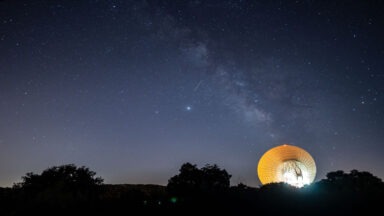The Eerie Apparition of White Rock Lake, Texas

Those who have reported seeing ghosts have long been the butt of jokes and derision, but the experience is far more common than people realize. It’s the stuff of history, with sightings in every culture throughout the world recorded in myriad, ancient records. And in Dallas, Texas, the White Rock Lake Ghost is no laughing matter. The familiar sighting is of a young woman in a drenched evening dress, who waves down drivers to tell them she’s been in a boating accident. She asks for a ride to a house, hops in the back seat, and then completely vanishes.
According to Dallas Parks and Recreation, “White Rock Lake is a 1,015-acre city lake located approximately 5 miles Northeast of downtown Dallas. White Rock is one of the most heavily used parks in the Dallas Park system.”
It’s a beautiful spot, and on a clear, warm day, there are cyclists, runners, families having picnics, and kayaks cutting lazily through the glassy lake. But there’s something more to this lake than meets the eye of the recreational visitor…
A Texas ABC affiliate reported the “Dallas Morning News posted a 1964 story from its archives about the ‘beautiful ghost of the lake,’ who reportedly wore a dress from Neiman Marcus. A 2004 story from the Advocate traced the beginning of the legend to the Texas Folk Lore Society, which published a story about the ghost in 1943. In that version, a couple picked up the soaking-wet woman on the side of the road and drove her to the address on Gaston Avenue. When they saw that she had disappeared, they walked up to the house. A man answered the door and explained that he had a daughter, but that she drowned in the lake two years earlier.”
You Are Not Alone
The New York Post conducted a study of 2,000 people, which showed that 60 percent said they had seen a ghost in their lifetime. “Also, more than 40 percent of those surveyed think their pet has seen one too. The research also found one in three people had either lived or stayed in a house they felt was haunted.”
According to The Guardian “Today, more Britons believe in ghosts than in God: in a recent survey of 2,012 people, 68% said they believed in the existence of ghosts, while 55% believed in the existence of God. (Where the holy spirit comes into this is uncertain.) The findings are supported by our undwindling appetite for ghost stories, ghost tours, and spiritualism…”
So, seeing a ghost is not as silly or strange as it sounds. Statistically, most people — at least those who admit to it — had the experience. And those who report seeing the ghost at White Rock Lake in Dallas, have amazingly shared similar accounts.
It All Started Back in 1943
According to the official White Rock Lake website, a woman named Anne Clark wrote the account of the Lady of the Lake legend and published it in 1943 under the title ‘The Ghost of White Rock,’ and it was included in the Texas Folklore Society’s publication, Backwoods to Border. Clark’s report stated that a young couple was parked on the shore of White Rock Lake, and when they turned on their headlights they saw a young girl in a sheer, wet, white dress coming toward them. With a “faltering voice,” she told the couple, “‘I’m sorry to intrude, and I would not under any circumstances, but I must find a way home immediately. My boat overturned. The others are safe. But I must get home.’” Next, she climbed into the rumble seat and gave the couple an address in Oak Cliff. When they asked her for directions, they turned around only to find their rumble seat empty and wet. Curious, the couple continued to the address the girl gave them. There they met a “sad man” at the door who told them, “This is a very strange thing. You are the third couple who has come to me with this story. Three weeks ago, while sailing on White Rock Lake, my daughter drowned.”
The Dallas Morning News reported that many Dallas residents wrote to the newspaper “to share their encounters with the girl.” In the archives of the News, reporter Frank Tolbert had run two emphatic pieces of the event in his column called Tolbert’s Texas. In 1964, he wrote, “Hundreds of people have called or written this department about the so-called ‘Girl Ghost of White Rock Lake,’ who sometimes, by testimony of sober witnesses, makes guest appearances in dripping wet evening dress along the shores of the Dallas lake, always at night and in the spring of the year.”
Are Ghosts Real?
The fact that so many people have reported such similar experiences begs for any materialist explanation. Are ghosts real? Is the lady in white an urban legend, or is it one of many supernatural events that are derided by skeptics? One thing that is for certain is that the Texas ghost, in the form of a young lady who failed to have realized her physical demise, has been sighted too many times to be casually written off as a hallucination or a prank.
Live Science notes, “There are many contradictions inherent in ideas about ghosts. For example, are ghosts material or not? Either they can move through solid objects without disturbing them, or they can slam doors shut and throw objects across the room. According to logic and the laws of physics, it’s one or the other. If ghosts are human souls, why do they appear clothed and with (presumably soulless) inanimate objects like hats, canes, and dresses — not to mention the many reports of ghost trains, cars, and carriages?”
Radford continued, “If ghosts are the spirits of those whose deaths were unavenged, why are there unsolved murders, since ghosts are said to communicate with psychic mediums, and should be able to identify their killers for the police. And so on — just about any claim about ghosts raises logical reasons to doubt it.”
On the other hand, just because someone hasn’t seen a ghost doesn’t prove that ghosts don’t exist. Logic has nothing to do with it. It’s like a twist on the old koan — If you see the ghost of a dripping wet young lady by White Rock Lake, Dallas, and nobody else is around to confirm, does that mean it never happened?
Can This Brainwave Study Explain What Happens to Consciousness When We Die?

A new study records the brain waves of a dying person in detail for the very first time. Could the findings explain what happens in our transition into death?
While there is plenty of anecdotal evidence from people who have had Near-death Experiences or NDEs, there is little to no hard scientific data on what happens in the brain as people are dying.
Now, researchers who recorded 15 minutes of brain wave activity in a dying man, are speculating that the findings may explain the phenomenon of life recall or review that many near-death experiencers report.
Dr. Eben Alexander is a neurosurgeon who, in 2008, experienced an NDE as he lay in a coma caused by a serious case of viral meningitis. After a miraculous recovery, he went on to write about the experience in several best-selling books.
“There’s a tremendous amount of evidence that, at the end of life, our consciousness does not just disappear as one might assume if the brain created consciousness,” Alexander said. “But in fact, our consciousness seems to expand in dramatic ways, and I think this is where a deeper understanding of NDEs is crucial for us to understand the mind-brain relationship and the nature of consciousness itself.”
To Alexander, while the study is a step in the right direction towards understanding what happens when we die, it is fraught with some misunderstandings.
“Now, there are many problems with this study and the main thing I’ll point out here is, first of all, do not confuse correlation with causality,” Alexander said.
“This is a common mistake in neuroscience and it results from the unproven assumption, and in fact, I would say a disproven assumption, that the brain is creating consciousness, and therefore, to find any change in phenomenal consciousness we must look for a neural correlate; some physiologic change in the brain. And modern studies just show that that reasoning is false, there’s more to it than just what’s going on in the brain.”




































